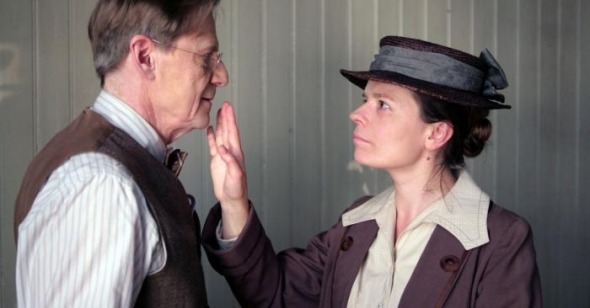Family Portrait
By Caroline McKenzie
Everlasting Moments
Dir. Jan Troell, Sweden, IFC Films
A death portrait is set up; a young girl in turn-of-the-century Sweden is the unfortunate subject. A middle-aged woman, Maria Larsson (Maria Heiskanen), arranges the scene and with a beloved camera snaps a first take while a pack of young boys peek in the window at the corpse. The photographer shoos them away, re-composes the shot to include only the departed child, and snaps again. The final portrait, shown to the girl’s mother, elicits joy: “She’s never looked so beautiful,” she cries. The first snapshot, though, is the favorite of the photographer’s mentor. By capturing the boys peering in the window over the deceased’s coffin, the portrait has captured both the dramatic heft and the spontaneity of everyday life in this small town.
This otherwise ghastly photograph becomes a mother’s prized possession and a vehicle for boosting Maria’s self-worth, but the persistent feeling of sad delusion created by the stark contrast between the misery of Maria’s life and the comfort of her photographed images (dubbed her “everlasting moments”) gnaws away at the film’s soft sentimentality, giving the work the occasional shock of pessimism when it could have otherwise melted into a tenderhearted puddle. At the same time, Maria’s portraits also suggest the false sense of security that photography offers.
The story of Maria, an impoverished mother of seven in early twentieth-century Sweden who finds release and renewal by peering through a camera lens, is at its best when it captures fragments of personal experiences off-the-cuff. There is beauty in every softly backlit shot (filmed by Troell himself and his cinematographer Mischa Gavrjusjov), but it is the digressive glances into the private moments of Maria and her family—the plucking of a pigeon for an evening meal, the plunging of Maria’s crippled child into a small pool, the reflection of a young maid in the clock face she just dusted—that bring the film close to some sort of transcendence.
However, Everlasting Moments does, like many period films before it, border on being overly precious. The film is noticeably more attuned to today’s television-absorbed contemporary audience than Troell’s works from the Seventies like The Emigrants (1971) and The New Land (1972)—while retaining some of the filmmaker’s signatures, Everlasting Moments is much more reliant on both the close-up and television’s systematized narrative structures than either of those canonized films. It is these story arcs that sometimes threaten to hamstring the film. Everlasting Moments opens with a visitor in Maria’s home inspecting a miniature ship in a bottle, crafted by Maria’s husband, Sigfrid (Mikael Persbrandt). As soon as the visitor comments on the beautiful craftsmanship, a highly intoxicated and out-of-control “Sigge” is dragged in the door by two officers. This too-perfectly orchestrated embarrassment is only the beginning of the many mistreatments to which Maria is subjected at the hands of her husband throughout the narrative. Through physical altercations, verbal spats, and emotional abuse, Maria stands by her husband. But while this could be considered simply a narrative contrivance to continually renew sympathy for the main character, Troell implies this also as a sad state of fact that for a working-class woman in Maria’s place and time. There really was nowhere else for her to go.
The introduction of a camera into Maria’s life gives new meaning to her existence, even if it doesn’t remove her from her pitiful marriage. Having won the camera in a raffle, Maria tries to sell it off to pay the bills. The professional photographer who convinces her to keep it despite her mounting financial and emotional crises—Mr. Pedersen (Jesper Christensen), affectionately known as Uncle “Piff Paff Puff”—is easily the film’s liveliest and most enjoyable character. An intelligent and loving man, he coaxes Maria into the world of photography and out of her shell, inviting her to take command of her surroundings by capturing them through her camera lens. Pedersen becomes the film’s emotional center, creating the few utterly happy moments in the otherwise bleak lives of the Larsson family. One of the film’s more tragic scenes comes when Maria spots for the first time that Pedersen has a wife and child. The emotions that register immediately on her face command understanding that it’s not so much the artistic pursuit but the human connections that Maria’s photography fosters that are saving her from a life not worth living. This brief encounter proves how economical Troell’s filmmaking can be.
Everlasting Moments seems more concerned with the fundamental human desire to express individuality than the emergence of artistic talent or the documenting of a historical period. Every time Maria clicks the shutter, she steps closer to emotional independence. Even so, the film closes with a freeze-frame snapshot of Maria and Sigge joyously dancing, followed by a self-portrait of Maria suspended in a developing bath. Directly referencing an earlier photograph of Maria’s crippled child floating in a pond, imagining momentarily that he is weightless and able to move freely, this “moment,” like many others, provides Maria a vehicle for escapism and self-comfort instead of a realistic view of her own small world.
